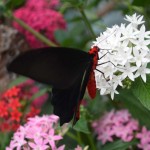ESCONDIDO — By Silas Hamernik’s count, at least 24 butterflies had landed on him as he walked through the exhibit. The 9-year-old, clad in a bright yellow shirt and jacket, seemed somewhat dismayed every time one of the insects would land on his arm, shoulder, back — even his shoe tops.
And there were probably plenty more by the time he left.
Last weekend marked the opening of the annual Butterfly Jungle exhibit at the San Diego Zoo Safari Park. The several week’s long exhibit allows guests an opportunity to walk among the butterflies, seeing 30 to 35 different species that have been imported from around the world.
The exhibit receives anywhere from 6,000 to 8,000 butterfly pupa for the display, said Don Sterner, animal care manager of the bird department at the San Diego Zoo Safari Park.
The pupa come mostly from butterfly farmers, which the park researches or from butterfly brokers that import the pupa and sell to the park.
“It’s very specific on what we can import,” Sterner said.
The USDA provides the regulations on what can be imported, because, Sterner added, technically, the butterflies in the exhibit are considered an agricultural pest.
Still, importing the pupa from butterfly farmers has a positive impact on the environment and supports a sort of eco-friendly business, Sterner explained.
“It’s something that the local people, in say Costa Rica, are involved in,” said Sterner. “When they become butterfly farmers, they realize that the rain forest around them provides these butterflies, which gives them an income. So they know not to disturb the forests.”
But because the imported butterflies are considered pests, extra staff is brought in, in part to stand guard at the exhibit’s exit, and perform a quick screening, ensuring that no butterfly is hitchhiking on someone’s clothing.
Park staff has also been receiving the butterfly pupa in the weeks leading up to the exhibit’s opening, carefully inspecting them for parasites that could pose a risk to native species or for species that might have been mistakenly shipped and aren’t allowed under the USDA regulations.
The pupas are received with such care, Sterner explained, and are unpacked in Plexiglass containers, almost as though staff was working with some sort of radioactive material.
Adding to the complexity of putting on the exhibit is the discouraging of breeding between the butterflies. While there’s nothing to prevent them from mating, the exhibit doesn’t provide host plants for caterpillars to feed on once they’ve hatched.
“We have to make sure the plants we have in here won’t encourage any sort of survivability of the caterpillars,” said Sterner. “That’s not to say they’re not going to breed and lay eggs anywhere, because that does happen, it’s just the fact that once the caterpillars hatch out they won’t have food items.”
The Butterfly Jungle does contain plenty of butterfly-friendly plants and flowers, however — a part of the educational component of the exhibit, which aims to raise awareness on the plight of local butterfly species.
“We have endangered species in San Diego County and with all the pesticides and habitat destruction going on, leaves less and less space for things to live, so (we’re) encouraging people to put out flowers to increase the survivability of the species,” Sterner said.
Another goal of the Butterfly Jungle is to tell the story of the Monarch butterfly and its epic migration from Canada to Mexico.
Sterner said they didn’t expect to receive any Monarch butterflies this year, but staff was surprised when they started showing up in the aviary.
Despite the short life spans of the butterflies, some will make it past the exhibit’s four-week long display.
Last year was the first time that the park began working with a botanical garden in Tucson, Ariz., sending the remaining surviving butterflies there once the exhibit closed.
They hope to do that again this year, said Sterner.
Zoos in the old days were about entertaining guests, now it’s to educate guests as to how wonderful animals are and the plight of animals and get people involved, Sterner explained.
“Bugs are animals, too,” he said. “They really are. People don’t think of it that way, but we’re trying to promote that.”
The Butterfly Jungle is open until April 10 and is included with the Park’s admission. Visit sdzsafaripark.org for more information.













